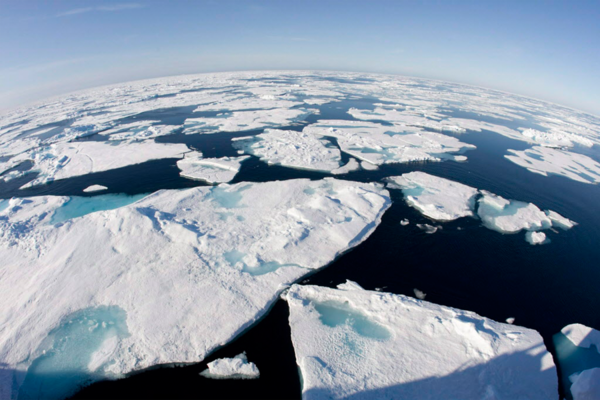As we push more urgently on the shift away from fossil fuel, and, perhaps, start to perfect technology around storage of carbon, it will be interesting to see if this trend quickly changes and the warming abates?
Why Arctic is warming twice as fast as rest of planet
by Olivia Lowenberg
A new report from NOAA indicates that the Arctic is warming faster than any other part of the world for the second straight year in a row.

This 2008 file photo made with a fisheye lens shows ice floes in Baffin Bay above the Arctic Circle, seen from the Canadian Coast Guard icebreaker Louis S. St-Laurent.
1 of 1
A new report from the National Oceanic and Atmospheric Administration (NOAA) indicates that the Arctic is warming faster than any other part of the world for the second straight year in a row.
The report, which is updated annually, found that the average surface-air temperature from Oct. 2014 to Oct. 2015 was about 2.5 degrees Fahrenheit higher than the 1981-2010 baseline, and that over time, levels of snow and ice have continued to decline while Arctic river flows have increased.
The report’s authors believe that these findings could contribute to both warming seas and higher sea levels around the globe.
These fluctuations that are causing the Arctic’s ice to melt so quickly are also making its walrus population vulnerable.
The Arctic is made up of two kinds of ice: younger surface ice, which tends to come and go each year, and older, denser ice, which forms the Arctic’s thicker lower layers. The Arctic is melting at such a rate that even the oldest ice layers, where walrus mothers prefer to give birth and raise their young, are melting, forcing walruses onto land.
“This is raising concern about the energetics of females and young animals that must now make feeding trips from coastal haul-outs to areas of high prey abundance … rather than utilizing nearby ice edges as they did in the past,” the NOAA report’s executive summary states.
"The massive concentration of walruses onshore – when they should be scattered broadly in ice-covered waters – is just one example of the impacts of climate change on the distribution of marine species in the Arctic,” Margaret Williams, World Wildlife Foundation’s managing director of the Arctic program, said in a statement.
These large hauls are at greater risk from the sharks and orcas that typically feed on them as they journey to their usual feeding grounds, or crushing one another in a stampede.
The report, which is updated annually, found that the average surface-air temperature from Oct. 2014 to Oct. 2015 was about 2.5 degrees Fahrenheit higher than the 1981-2010 baseline, and that over time, levels of snow and ice have continued to decline while Arctic river flows have increased.
The report’s authors believe that these findings could contribute to both warming seas and higher sea levels around the globe.
Take Action:
“The conclusion that comes to my mind is these report cards are trailing indicators of what’s happening in the Arctic. They can turn out to be leading indicators for the rest of the globe,” NOAA chief scientist Richard Spinrad told The Washington Post.
The Arctic is made up of two kinds of ice: younger surface ice, which tends to come and go each year, and older, denser ice, which forms the Arctic’s thicker lower layers. The Arctic is melting at such a rate that even the oldest ice layers, where walrus mothers prefer to give birth and raise their young, are melting, forcing walruses onto land.
“This is raising concern about the energetics of females and young animals that must now make feeding trips from coastal haul-outs to areas of high prey abundance … rather than utilizing nearby ice edges as they did in the past,” the NOAA report’s executive summary states.
Take Action:
Haul outs, or large gatherings, of walruses can occur both during mating season and after. The NOAA reports that large haul-outs, which were first observed in 2007, have increased in number over time. In 2014, 35,000 walruses were observed on a beach in Alaska, one of the largest walrus gatherings recorded.
Haul outs, or large gatherings, of walruses can occur both during mating season and after. The NOAA reports that large haul-outs, which were first observed in 2007, have increased in number over time. In 2014, 35,000 walruses were observed on a beach in Alaska, one of the largest walrus gatherings recorded.
"The massive concentration of walruses onshore – when they should be scattered broadly in ice-covered waters – is just one example of the impacts of climate change on the distribution of marine species in the Arctic,” Margaret Williams, World Wildlife Foundation’s managing director of the Arctic program, said in a statement.
These large hauls are at greater risk from the sharks and orcas that typically feed on them as they journey to their usual feeding grounds, or crushing one another in a stampede.

No comments:
Post a Comment